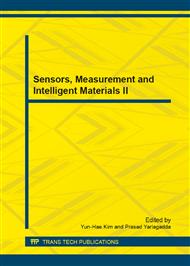[1]
Yashpalsing Chavhan, M. L. Dhore, Pallavi Yesaware, Speech Emotion Recognition Using Support Vector Machine, International Journal of Computer Applications, vol. 1, pp.6-9, February (2010).
DOI: 10.5120/431-636
Google Scholar
[2]
He L., Lech M., Maddage N., Memon S., and Allen N., Emotion Recognition in Spontaneous Speech within Work and Family Environments, iCBBE (2009).
DOI: 10.1109/icbbe.2009.5162772
Google Scholar
[2]
Franco H, Neumeyer L, Ramos M, et al. Automatic detection of phone-level mispronunciation for language learning[C]/Proc. Eurospeech. 1999, 2: 851-854.
DOI: 10.21437/eurospeech.1999-207
Google Scholar
[3]
Franco H, Neumeyer L, Kim Y, et al. Automatic pronunciation scoring for language instruction[C]/Acoustics, Speech, and Signal Processing, 1997. ICASSP-97., 1997 IEEE International Conference on. IEEE, 1997, 2: 1471-1474.
DOI: 10.1109/icassp.1997.596227
Google Scholar
[4]
Kim Y, Franco H, Neumeyer L. Automatic pronunciation scoring of specific phone segments for language instruction[C]/Proc. Eurospeech. 1997, 97: 645-649.
DOI: 10.21437/eurospeech.1997-230
Google Scholar
[5]
Neumeyer L, Franco H, Weintraub M, et al. Automatic text-independent pronunciation scoring of foreign language student speech[C]/Spoken Language, 1996. ICSLP 96. Proceedings., Fourth International Conference on. IEEE, 1996, 3: 1457-1460.
DOI: 10.21437/icslp.1996-372
Google Scholar
[6]
D. F. Specht, Probabilistic neural networks, Neural Networks, vol. 3, pp.109-118, (1990).
Google Scholar
[7]
Ezzat T., Tomaso Poggio T. Discriminative Word-Spotting Using Ordered Spectro-Temporal Patch Features, to appear, SAPA workshop, Interspeech, Brisbane, Australia, (2008).
Google Scholar
[8]
Frank,A. &Asuncion,A. (2010). UCI Machine Learning Repository [http: /archive. ics. uci. ed u/ml] . Irvine, CA: University of California, School of Information and Computer Science.
Google Scholar
[9]
Burkhardt F, Paeschke A, Rolfes M, et al. A database of German emotional speech[C]/Proc. Interspeech, (2005).
DOI: 10.21437/interspeech.2005-446
Google Scholar
[10]
Bouvrie J., Ezzat T., Poggio T., Localized Spectro-Temporal Cepstral Analysis of Speech, ICASSP, Las Vegas, Nevada, (2008).
DOI: 10.1109/icassp.2008.4518714
Google Scholar
[11]
Keogh E. Exact indexing of dynamic time warping[C]/Proceedings of the 28th international conference on Very Large Data Bases. VLDB Endowment, 2002: 406-417.
DOI: 10.1016/b978-155860869-6/50043-3
Google Scholar
[12]
Jyh-Shing Roger Jang, Speech and Audio Processing (SAP) Toolbox", available at "http: /mirlab. org/jang/matlab/toolbox/sap.
Google Scholar


